
上一章我们讲解了在springsecurity中的基础配置,现在我们再来看看springsecurity的基础架构
系列其它文章
springboot整合springsecurity从Hello World到源码解析(一):hello world程序入门
springboot整合springsecurity从Hello World到源码解析(二):springsecurity配置加载解析
springboot整合springsecurity从Hello World到源码解析(三):基础配置详解
springboot整合springsecurity从Hello World到源码解析(四):springsecurity基础架构解析
springboot整合springsecurity从Hello World到源码解析(五):springsecurity+jwt整合restful服务
Authentication and Access Control(认证和授权)
认证(authentication)和授权(authorization,有的叫Access Control)是所有权限控制框架所要考虑的两个问题,认证就是我们翻译过来就是 “你是谁”,我们可以理解为登录,而授权则是登陆过后明白自己
有哪些事情可以做,我们可以理解为 ”你可以做什么“,而在springsecurity将这两者完全分开,并且提供了不同的策略去定义它们。
Authentication(认证)
在springsecurity中,认证的主要策略接口是AuthenticationManager,嘿嘿,有没有想到我们上一章自定义DetailsService时configure方法就是它(应该说是它的 builder)
public interface AuthenticationManager {
Authentication authenticate(Authentication authentication)
throws AuthenticationException;
}
它通过authenticate主要可以做三件事情:
- 认证成功后返回一个Authentication对象。
- 丢出一个AuthenticationException异常,如果认证失败。
- 如果它决定不了,返回一个null。
而我们对于这个AuthenticationException,springsecurity建议不要自己去catch它,因为springsecurity会自己渲染一个权限错误的页面出来然后展示,并且加上一个WWW-Authenticate头。
AuthenticationManager的常用子类是ProviderManager,并且提供了更多的方法,主要成员变量如下:
public class ProviderManager implements AuthenticationManager, MessageSourceAware,
InitializingBean {
// ~ Static fields/initializers
// =====================================================================================
private static final Log logger = LogFactory.getLog(ProviderManager.class);
// ~ Instance fields
// ================================================================================================
private AuthenticationEventPublisher eventPublisher = new NullEventPublisher();
private List<AuthenticationProvider> providers = Collections.emptyList();
protected MessageSourceAccessor messages = SpringSecurityMessageSource.getAccessor();
private AuthenticationManager parent;
private boolean eraseCredentialsAfterAuthentication = true;
public ProviderManager(List<AuthenticationProvider> providers) {
this(providers, null);
}
public ProviderManager(List<AuthenticationProvider> providers,
AuthenticationManager parent) {
Assert.notNull(providers, "providers list cannot be null");
this.providers = providers;
this.parent = parent;
checkState();
}
}
我们可以看出,它内部代理了一个 AuthenticationProvider链,而AuthenticationProvider如下:
public interface AuthenticationProvider {
Authentication authenticate(Authentication authentication)
throws AuthenticationException;
boolean supports(Class<?> authentication);
}
和AuthenticationManager几乎一样,多了一个supports方法,这个方法的作用是用来指定哪些Authentication可以进行权限判断。所以如果我们能自定义Authentication,就要这里返回true了,另外
我们再来重点关注下ProviderManager实现的 authenticate方法:
public Authentication authenticate(Authentication authentication)
throws AuthenticationException {
Class<? extends Authentication> toTest = authentication.getClass();
AuthenticationException lastException = null;
Authentication result = null;
Authentication parentResult = null;
boolean debug = logger.isDebugEnabled();
for (AuthenticationProvider provider : getProviders()) {
if (!provider.supports(toTest)) {
continue;
}
if (debug) {
logger.debug("Authentication attempt using "
+ provider.getClass().getName());
}
try {
result = provider.authenticate(authentication);
if (result != null) {
copyDetails(authentication, result);
break;
}
}
catch (AccountStatusException e) {
prepareException(e, authentication);
// SEC-546: Avoid polling additional providers if auth failure is due to
// invalid account status
throw e;
}
catch (InternalAuthenticationServiceException e) {
prepareException(e, authentication);
throw e;
}
catch (AuthenticationException e) {
lastException = e;
}
}
if (result == null && parent != null) {
// Allow the parent to try.
try {
result = parentResult = parent.authenticate(authentication);
}
catch (ProviderNotFoundException e) {
// ignore as we will throw below if no other exception occurred prior to
// calling parent and the parent
// may throw ProviderNotFound even though a provider in the child already
// handled the request
}
catch (AuthenticationException e) {
lastException = e;
}
}
if (result != null) {
if (eraseCredentialsAfterAuthentication
&& (result instanceof CredentialsContainer)) {
// Authentication is complete. Remove credentials and other secret data
// from authentication
((CredentialsContainer) result).eraseCredentials();
}
// If the parent AuthenticationManager was attempted and successful than it will publish an AuthenticationSuccessEvent
// This check prevents a duplicate AuthenticationSuccessEvent if the parent AuthenticationManager already published it
if (parentResult == null) {
eventPublisher.publishAuthenticationSuccess(result);
}
return result;
}
// Parent was null, or didn't authenticate (or throw an exception).
if (lastException == null) {
lastException = new ProviderNotFoundException(messages.getMessage(
"ProviderManager.providerNotFound",
new Object[] { toTest.getName() },
"No AuthenticationProvider found for {0}"));
}
prepareException(lastException, authentication);
throw lastException;
}
不难看出,就是经过 AuthenticationProvider链一个一个验证,如果一个没有通过,就验证失败,如果都决定不了,由其内部的parent(默认为null)在来决定一次。最后没有结果,就丢出异常。
这个内部的parent是用来定义不同资源的访问控制的公共行为的,所以结构图变成了如图:
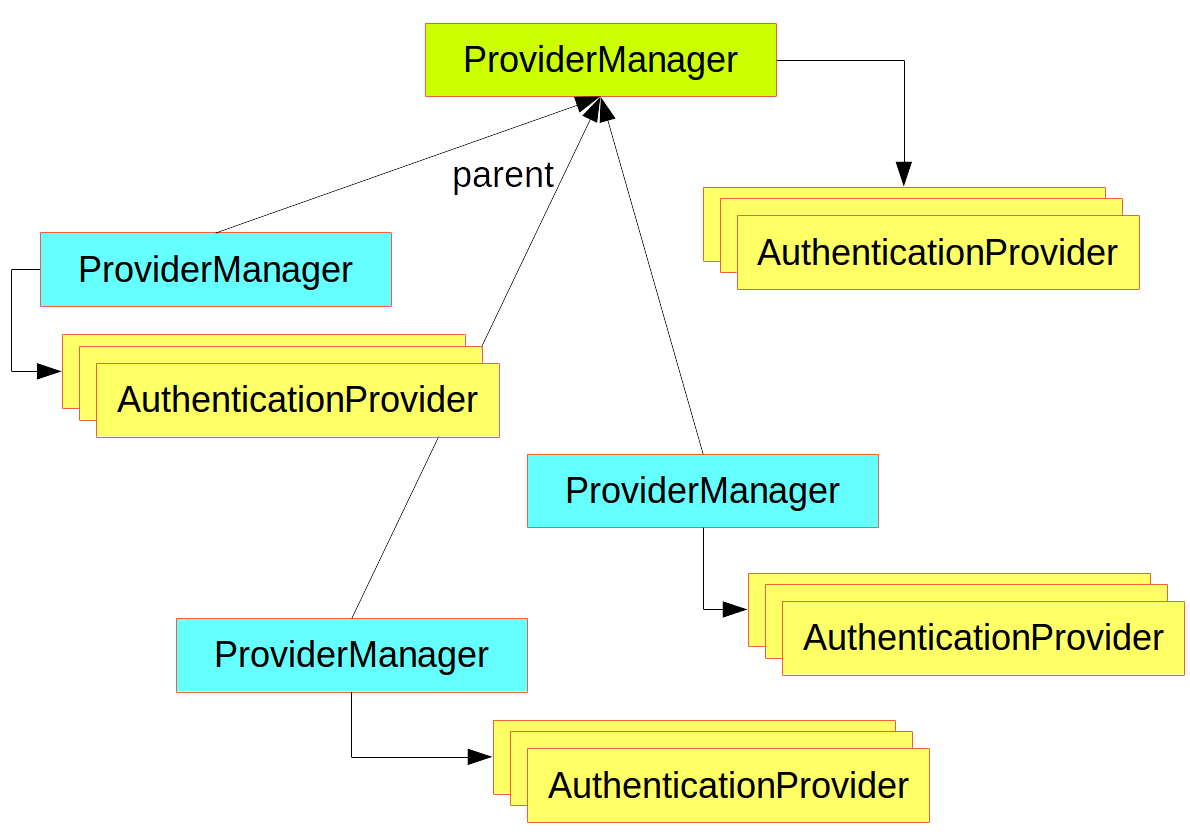
说了这么多,那我们怎么自定义AuthenticationManager呢? 其实我们上一章已经演示了,继承 protected void configure(AuthenticationManagerBuilder auth)
或者通过@AutoWired注入也行,所以有了它,就可以”为所欲为了“,比如:
@Autowired
DataSource dataSource;
... // web stuff here
@Override
public configure(AuthenticationManagerBuilder builder) {
builder.jdbcAuthentication().dataSource(dataSource).withUser("jsbintask")
.password("secret").roles("USER");
}
Authorization or Access Control(授权)
一旦某个实体通过了上面的认证阶段,接下来就该关心授权了!
授权的核心类是AccessDecisionManager,如下:
public interface AccessDecisionManager {
void decide(Authentication authentication, Object object,
Collection<ConfigAttribute> configAttributes) throws AccessDeniedException,
InsufficientAuthenticationException;
boolean supports(ConfigAttribute attribute);
boolean supports(Class<?> clazz);
}
它有一个抽象继承类,并且三个主要实现类,如下:
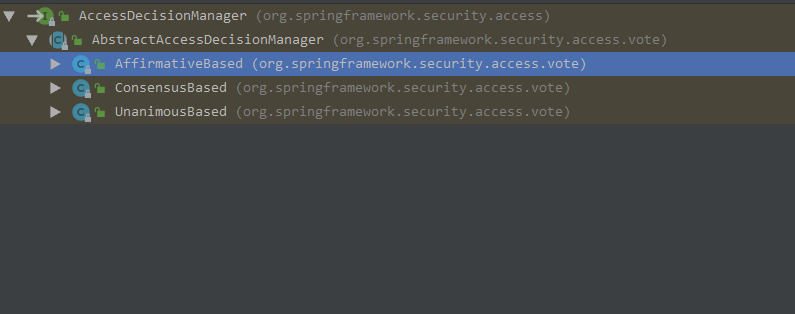
首先我们看下它的默认抽象实现类,AbstractAccessDecisionManager:
public abstract class AbstractAccessDecisionManager implements AccessDecisionManager,
InitializingBean, MessageSourceAware {
// ~ Instance fields
// ================================================================================================
protected final Log logger = LogFactory.getLog(getClass());
private List<AccessDecisionVoter<? extends Object>> decisionVoters;
protected MessageSourceAccessor messages = SpringSecurityMessageSource.getAccessor();
private boolean allowIfAllAbstainDecisions = false;
protected AbstractAccessDecisionManager(
List<AccessDecisionVoter<? extends Object>> decisionVoters) {
Assert.notEmpty(decisionVoters, "A list of AccessDecisionVoters is required");
this.decisionVoters = decisionVoters;
}
}
是不是相似的感觉,它内部有一个 AccessDecisionVoter 链,和上面的ProviderManager一个套路,这个AccessDecisionVoter我们就叫投票器,如下:
public interface AccessDecisionVoter<S> {
int ACCESS_GRANTED = 1;
int ACCESS_ABSTAIN = 0;
int ACCESS_DENIED = -1;
boolean supports(ConfigAttribute attribute);
boolean supports(Class<?> clazz);
int vote(Authentication authentication, S object,
Collection<ConfigAttribute> attributes);
}
果然,同一个框架,同一个套路,它又和核心授权AccessDecisionManager接口长得几乎一毛一样,那我们再来重点看下decide方法,但是他在抽象类中没有实现,还有三个子类(上图),
通过debug我们知道(不演示了,哈哈),默认实现是AffirmativeBased,它实现的方法如下:
public void decide(Authentication authentication, Object object,
Collection<ConfigAttribute> configAttributes) throws AccessDeniedException {
int deny = 0;
for (AccessDecisionVoter voter : getDecisionVoters()) {
int result = voter.vote(authentication, object, configAttributes);
if (logger.isDebugEnabled()) {
logger.debug("Voter: " + voter + ", returned: " + result);
}
switch (result) {
case AccessDecisionVoter.ACCESS_GRANTED:
return;
case AccessDecisionVoter.ACCESS_DENIED:
deny++;
break;
default:
break;
}
}
if (deny > 0) {
throw new AccessDeniedException(messages.getMessage(
"AbstractAccessDecisionManager.accessDenied", "Access is denied"));
}
// To get this far, every AccessDecisionVoter abstained
checkAllowIfAllAbstainDecisions();
}
熟悉的味道,和上面认证一样,它也通过 AccessDecisionVoter来施行一票否决权,一个投票人反对,就丢出异常。
然后我们看下投票器投票的方法参数:
int vote(Authentication authentication, S object, Collection<ConfigAttribute> attributes);
authentication不用说,在系统就是用户的标识,object则是代表你要访问的资源,比如方法,类,文件等等,attributes则是访问该资源需要的标识(有点晦涩),
打个比方,如果访问UserController需要又User身份,那这个attributes则是代表 user,它是一个字符串,然后去查找authentication是否有改字符串,有的话投票通过,没有丢出异常。
例如 hasRole(‘user’)代表的标识即是 ROLE_USER,。 以上就是认证和授权的核心代码解析了,接下来我们看看web环境中的过滤器链。
Web Security
首先看图,在servlet容器中,过滤器和servlet的关系如下:
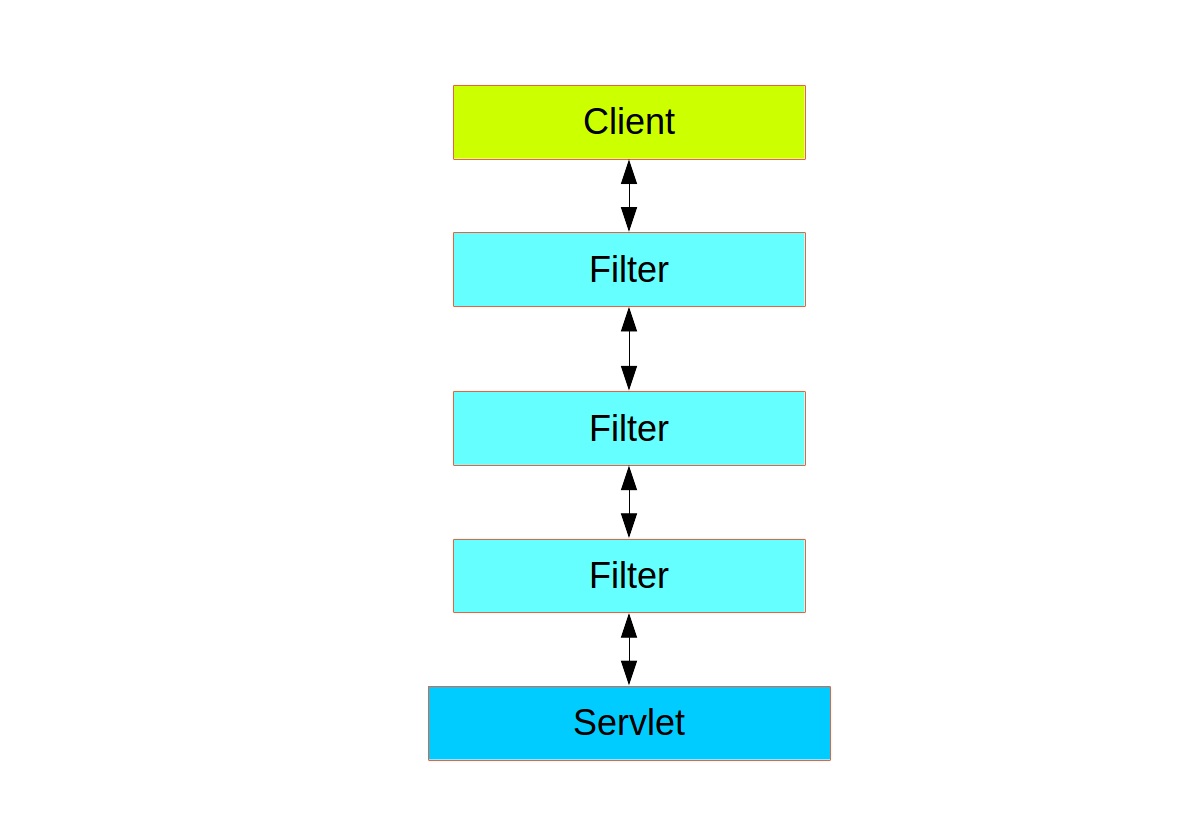
一个http请求最多可由一个servlet处理,但是filter可以有多个,所以filter肯定是有顺序的,因为在filter中是可以处理request的,所以这个时候顺序就显得很重要
第二章我们已经知道,springsecurity的过滤器链是由一个FilterChainProxy代理,它作为入口,然后进入过滤器链,而这个入口过滤器的装载顺序如下:

SecurityProperties.DEFAULT_FILTER_ORDER,这个值是比较小的,也就是说它基本就是最后访问的filter了(当然,这只是springboot默认这么做了),最后filter链的结构如下:
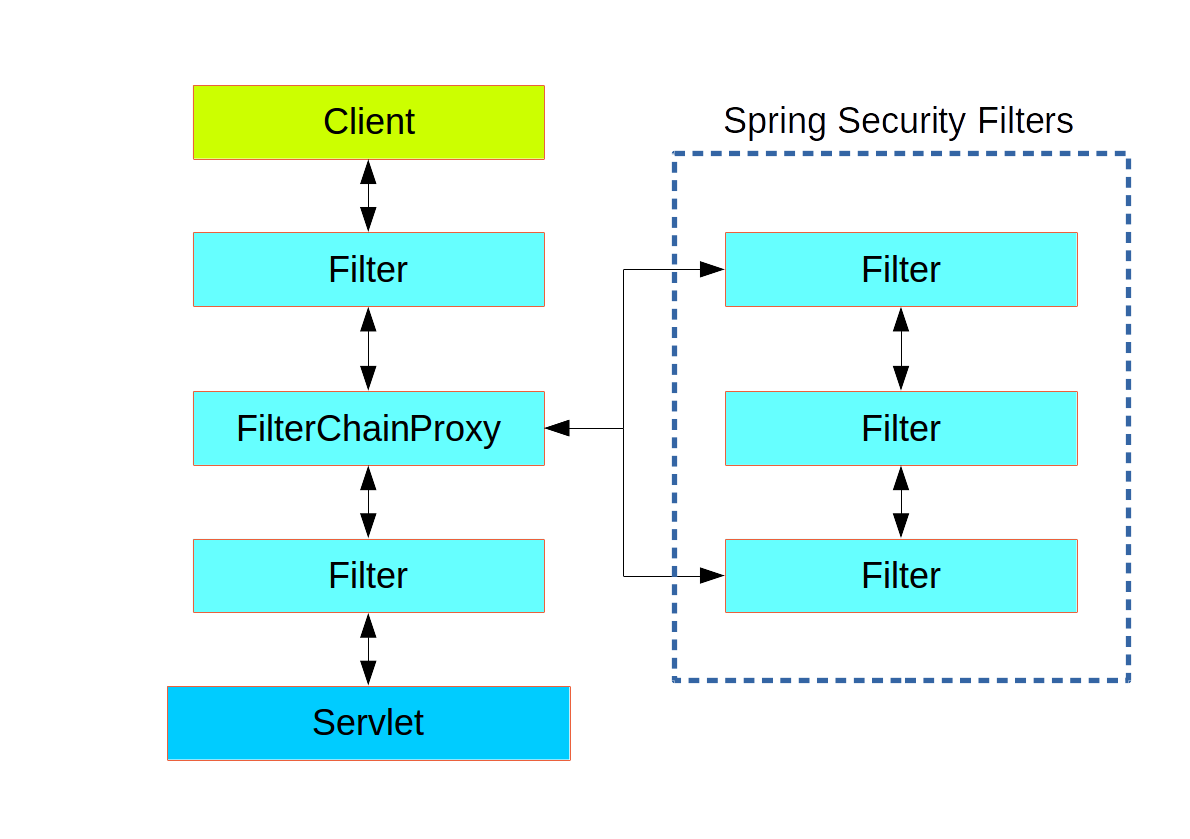
事实上,入口的FilterChainProxy 的可以代理多个过滤器链,所以对于不同的url,springsecurity可以创建不同的过滤器链,如下:
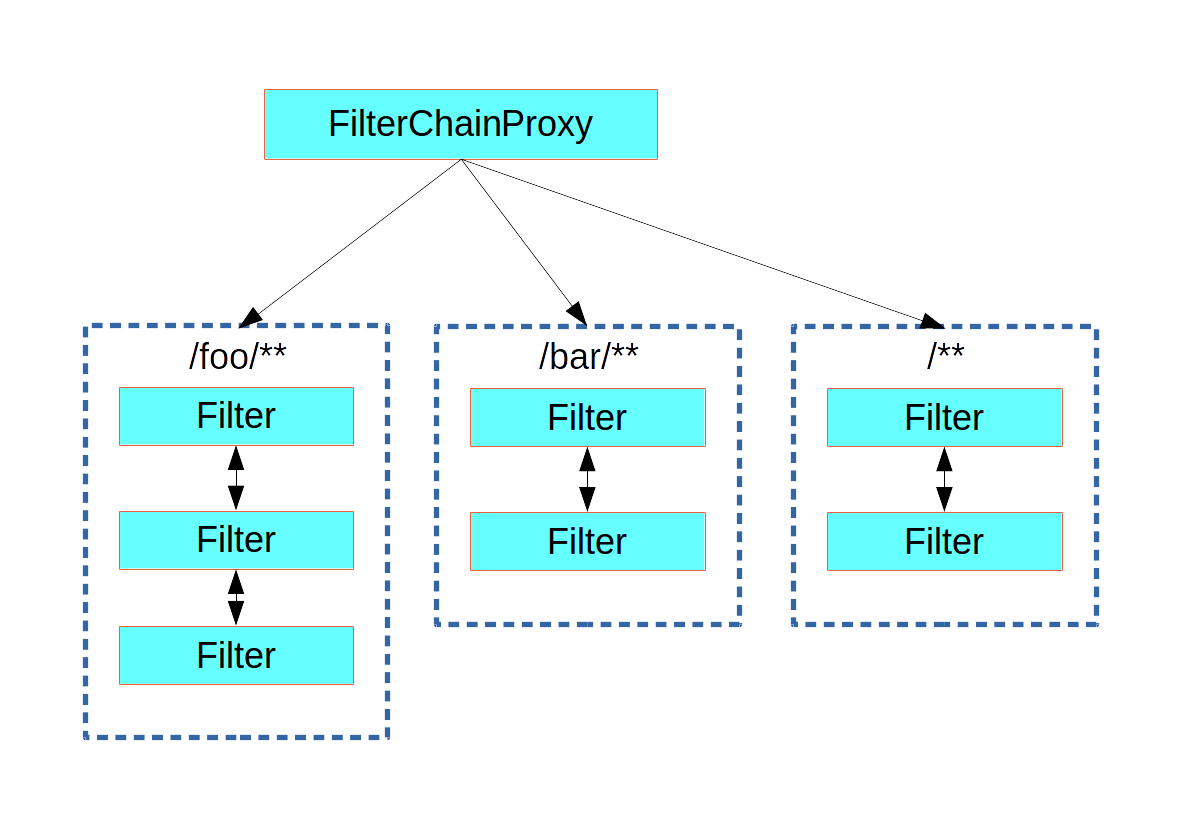
例如,如果我们的springboot直接构建,加入security依赖,会帮我创建6个过滤器链,并且其中的第一个过滤器链就是放行静态资源,如:
/css/** and /images/**, 而最后的一个过滤器链则是匹配所有 /**,也就是我们debug看到的11个默认的过滤器,认证,授权,写头,session管理,异常处理都是在这个默认的过滤器链中,当然
一般情况下我们也不需要去管它们(了解下),至于怎么创建多个过滤器链(api分模块开发可能用到)? 那就是继承多个 WebSecurityAdapter,就像我们之前定义的那样,然后加上**@Order**,如果他们的拦截url
重叠了,当然就是排在前的 过滤器链生效了!例如我们可以这么配置:
@Configuration
@Order(SecurityProperties.BASIC_AUTH_ORDER - 10)
public class ApplicationConfigurerAdapter extends WebSecurityConfigurerAdapter {
@Override
protected void configure(HttpSecurity http) throws Exception {
http.antMatcher("/foo/**")
.authorizeRequests()
.antMatchers("/foo/bar").hasRole("BAR")
.antMatchers("/foo/spam").hasRole("SPAM")
.anyRequest().isAuthenticated();
}
}
它表示拦截所有 /foo/下面的请求,并且 访问 /foo/bar需要有 BAR角色,访问/foo/spam需要有 SPAM角色,其他所有请求均需要认证过后才能访问。
方法安全
上面说了springsecurity的过滤器链的定义,接下来我们说一点在springsecurity中的常用安全注解(好像有点超纲了)。
首先我们需要开启方法安全配置,在有@Configuration注解的地方加上**@EnableGlobalMethodSecurity**,它的属性如下:不同名字加上enable就代表可以用对应的注解:
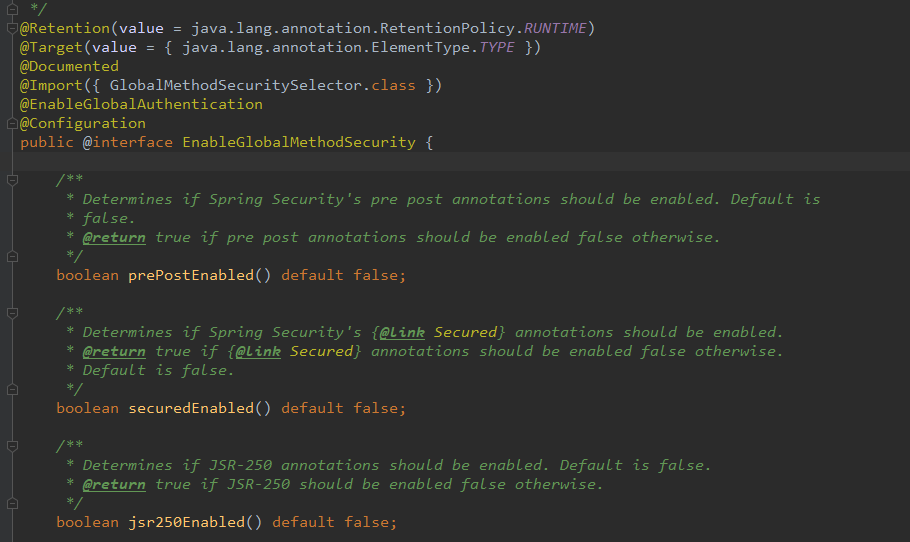
例如加上 securedEnabled = true,我们就可以这么玩,在service或者controller方法上面:
@Service
public class MyService {
@Secured("ROLE_USER")
public String secure() {
return "Hello Security";
}
}
加上prePostEnabled=true,就可以这么玩: @PreAuthorize("{{spel}}"), 其中{{spel}}代表一个表达式,如: “hasAnyAuthority(‘test’)”,
而一旦用户对应的Authentication没有相应的 test,spel表达式所代表的值,就会丢出AccessDeniedException 异常(下章具体看看这些权限怎么设置)。
工作方式
好了,基本我们本章索要讲的东西差不多了,另外还有一个问题,既然springsecurity中把用户以及它的权限表现为一个Authentication,那它的流程应该是这样的:
认证成功-》生成authentication-》访问某个特定资源(比如方法)-》检查该authentication是否由该资源的权限-》 1.有(放行) 2.无(丢出异常)-》清除authentication。
该流程我们应该已经明白,那问题就是: 这个 authentication springsecurity帮我们放在哪了呢? 既要能随时能取出来,又能清除,然后如果有很多用户,又要能随时标识不错乱。
相信各位已经明白,一个很方便的方法就是 和当前线程绑定在一起! 那就是 ThreadLocal,当然在springsecurity是通过 SecurityContextHolder来操作这个类的,我们来看下它内部是什么:
public class SecurityContextHolder {
// ~ Static fields/initializers
// =====================================================================================
public static final String MODE_THREADLOCAL = "MODE_THREADLOCAL";
public static final String MODE_INHERITABLETHREADLOCAL = "MODE_INHERITABLETHREADLOCAL";
public static final String MODE_GLOBAL = "MODE_GLOBAL";
public static final String SYSTEM_PROPERTY = "spring.security.strategy";
private static String strategyName = System.getProperty(SYSTEM_PROPERTY);
private static SecurityContextHolderStrategy strategy;
private static int initializeCount = 0;
static {
initialize();
}
private static void initialize() {
if (!StringUtils.hasText(strategyName)) {
// Set default
strategyName = MODE_THREADLOCAL;
}
if (strategyName.equals(MODE_THREADLOCAL)) {
strategy = new ThreadLocalSecurityContextHolderStrategy();
}
else if (strategyName.equals(MODE_INHERITABLETHREADLOCAL)) {
strategy = new InheritableThreadLocalSecurityContextHolderStrategy();
}
else if (strategyName.equals(MODE_GLOBAL)) {
strategy = new GlobalSecurityContextHolderStrategy();
}
else {
// Try to load a custom strategy
try {
Class<?> clazz = Class.forName(strategyName);
Constructor<?> customStrategy = clazz.getConstructor();
strategy = (SecurityContextHolderStrategy) customStrategy.newInstance();
}
catch (Exception ex) {
ReflectionUtils.handleReflectionException(ex);
}
}
initializeCount++;
}
}
可以看出,除非通过jvm指定,不然默认生成了一个ThreadLocalSecurityContextHolderStrategy,然后它内部是这样子的:
final class ThreadLocalSecurityContextHolderStrategy implements
SecurityContextHolderStrategy {
// ~ Static fields/initializers
// =====================================================================================
private static final ThreadLocal<SecurityContext> contextHolder = new ThreadLocal<>();
// ~ Methods
// ========================================================================================================
public void clearContext() {
contextHolder.remove();
}
public SecurityContext getContext() {
SecurityContext ctx = contextHolder.get();
if (ctx == null) {
ctx = createEmptyContext();
contextHolder.set(ctx);
}
return ctx;
}
public void setContext(SecurityContext context) {
Assert.notNull(context, "Only non-null SecurityContext instances are permitted");
contextHolder.set(context);
}
public SecurityContext createEmptyContext() {
return new SecurityContextImpl();
}
}
果然,内部是ThreadLocal,所以springsecurity是帮我们把Authentication放到了threadlocal中,我们回想第二章登录的例子,有一个UsernamePasswordAuthenticationFilter,大胆猜测如果通过认证,
就是在这个过滤器中加入的,那我们debug看下:
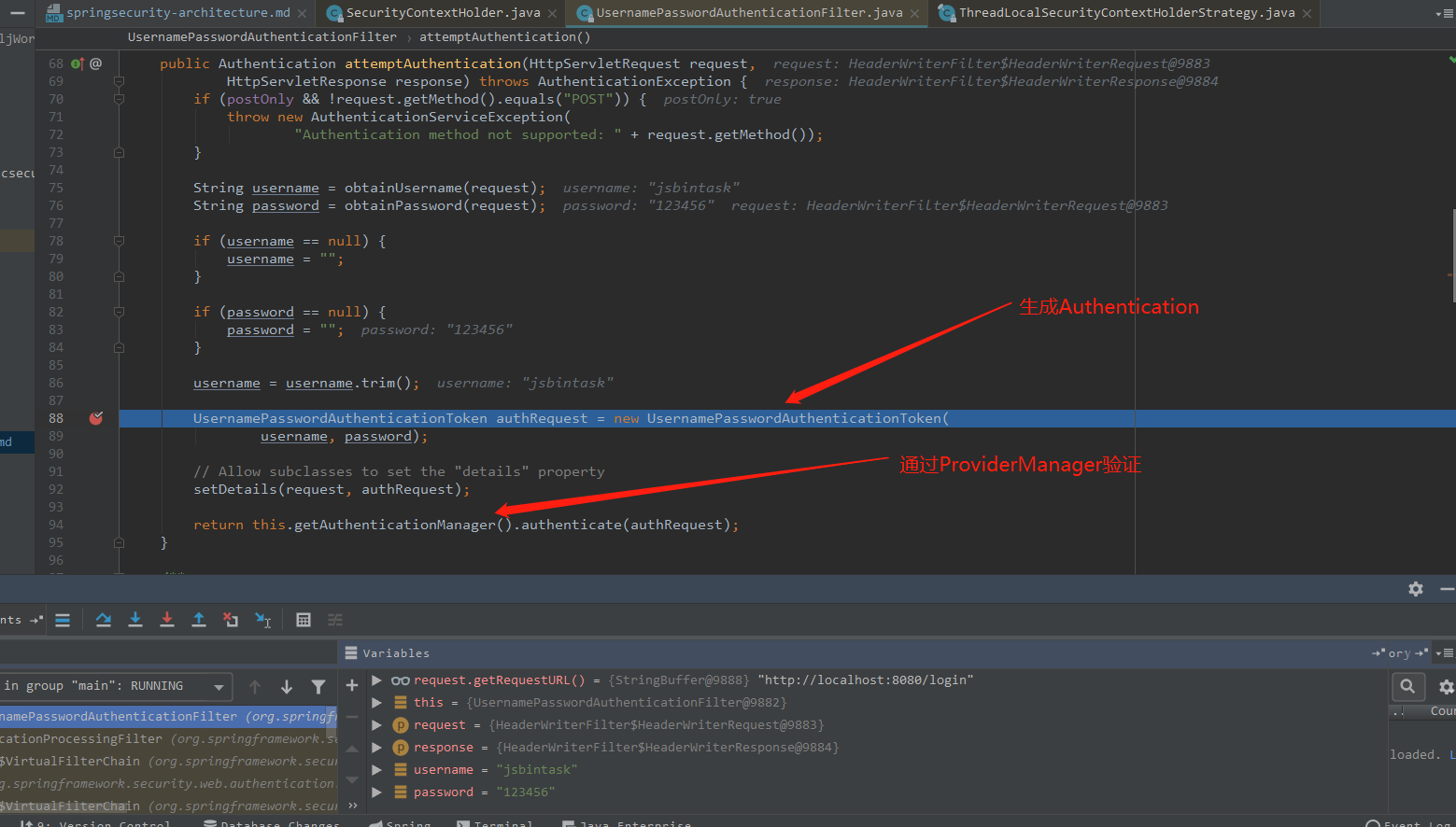
图上已经说清楚了,那结果就是经过ProviderManager后,验证通过,然后继续走:
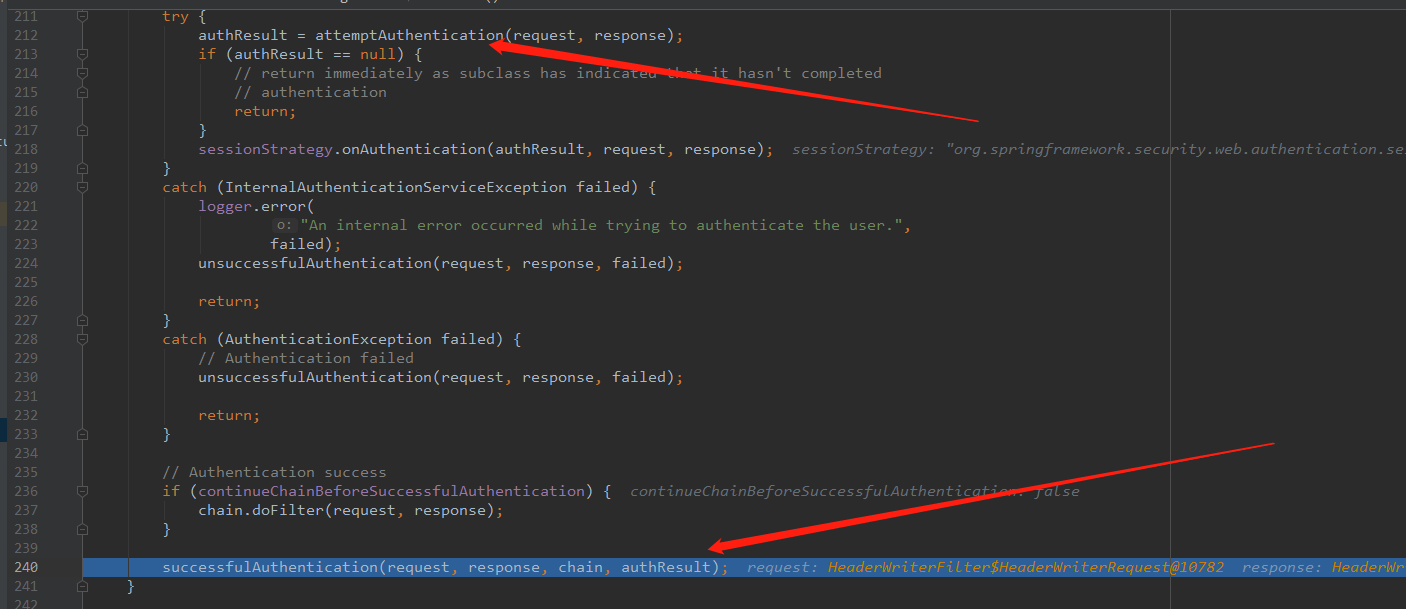
最后走successfulAuthentication这个方法,最终,这个方法我们找到了答案:
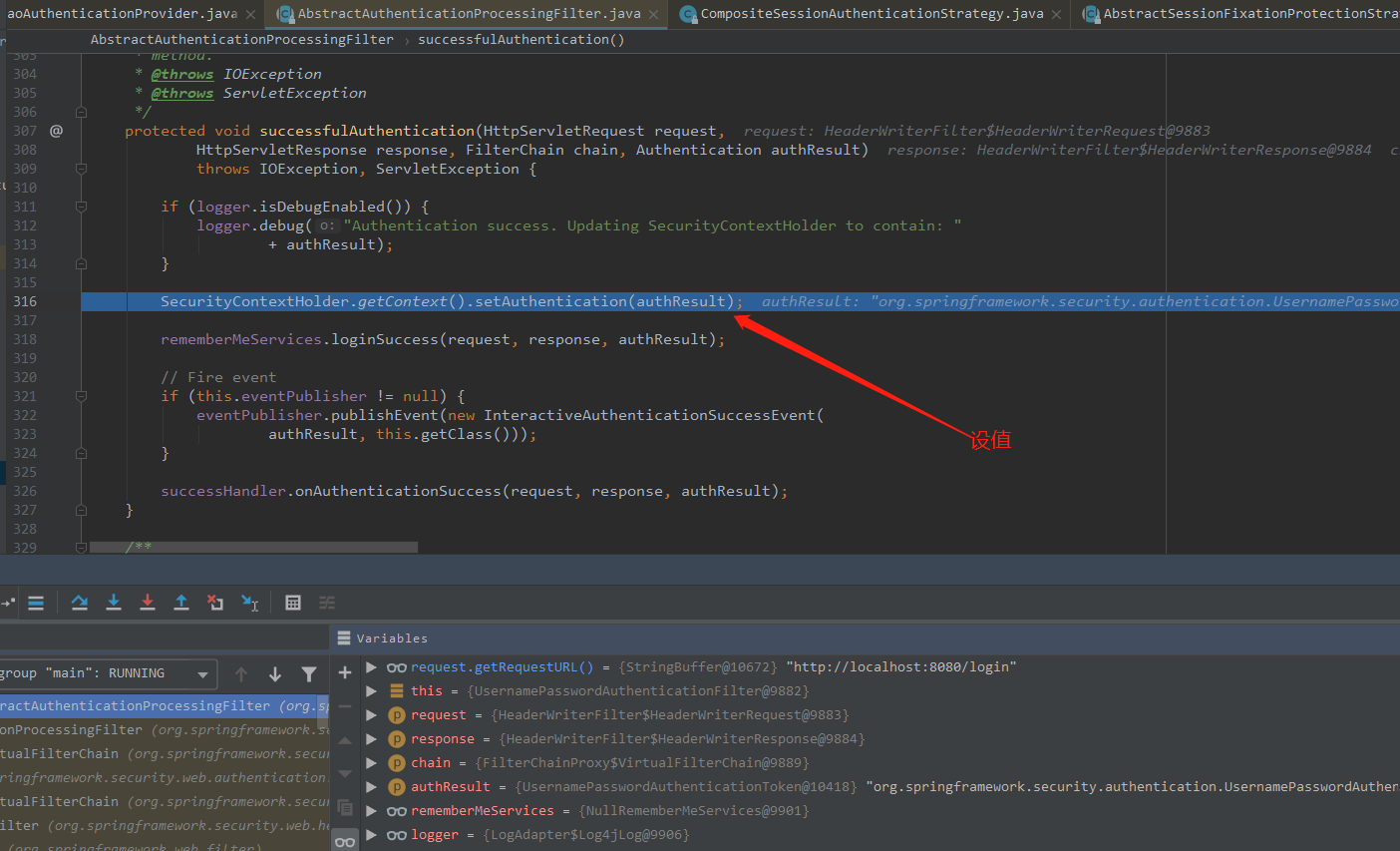
设置成功后,就是帮我们转发到了主页面了。 所以后面这个SecurityContext有了值以后,我们就可以在controller或者其它地方随意使用了。
使用方法就是 **SecurityContextHolder.getContext().getAuthentication()**了,当然springsecurity提供了一种更加简便的方式,controller中:
@RequestMapping("/foo")
public String foo(@AuthenticationPrincipal User user) {
... // do stuff with user
}
这里的user就是通过**SecurityContextHolder.getContext().getAuthentication().getPrincipal()**得出来的,当然,你也可以这么写:
@RequestMapping("/foo")
public String foo(Principal principal) {
Authentication authentication = (Authentication) principal;
User = (User) authentication.getPrincipal();
... // do stuff with user
}
小结
本章,我们首先分析了springsecurity的基础结构,以及它们是如何工作的,然后又通过源码简单验证了我们的分析。 最后介绍了一些使用方法,接下来就是我们的最后一章了。
springboot+springsecurity+jwt整合 restful 服务。
本文原创地址,我的博客:https://jsbintask.cn/2019/01/16/springsecurity-architecture/#more
系列其它文章
springboot整合springsecurity从Hello World到源码解析(一):hello world程序入门
springboot整合springsecurity从Hello World到源码解析(二):springsecurity配置加载解析
springboot整合springsecurity从Hello World到源码解析(三):基础配置详解
springboot整合springsecurity从Hello World到源码解析(四):springsecurity基础架构解析
springboot整合springsecurity从Hello World到源码解析(五):springsecurity+jwt整合restful服务
关注我!
